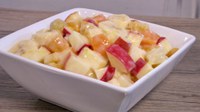Prairie Fare: Do You Need a Vitamin Pill?
(Click an image below to view a high-resolution image that can be downloaded)
By Julie Garden-Robinson, Food and Nutrition Specialist
NDSU Extension Service
“You need to eat more vegetables,” my husband said to our 13-year-old daughter.
He was scraping the uneaten vegetables from her plate while she was getting a daily kids’ vitamin for herself. I walked into the kitchen during their conversation.
“I really don’t like vegetables,” she announced a little sheepishly.
I can attest that she has been my challenging vegetable eater, but she is similar to lots of kids in that respect. She takes the once-daily vitamin as a little “nutrition insurance policy.”
“Eating a vitamin isn’t going to make up for leaving your vegetables on your plate,” he added.
“Go, Dad!” I thought to myself. I couldn’t have said it better myself.
“I like carrots and cauliflower but not green vegetables,” she said as she glanced in my direction. “You need to buy some cauliflower, Mom.”
“I can do that,” I said.
I also will invite her into the kitchen to help prepare the cauliflower. When kids help prepare food, they are more likely to eat it.
Along with a select group of vegetables, my daughter likes fruit, so she probably is fine in terms of vitamin and fiber intake. She also eats beans, such as kidney and navy beans, which can count as a protein or a vegetable.
Eating a rainbow of fruits and vegetables is one visual way to determine how we are doing on nutrient intake. Orange and dark green vegetables are most likely to be lacking in our diet.
The latest nutrition advice (https://www.choosemyplate.gov) reminds us to fill half of our plate with fruits and vegetables. Think of your dinner plate divided into fourths. Fill a generous one-fourth of the plate with vegetables and the other fourth with fruit. Grains, especially whole grains, and lean protein make up each of the sections of the plate. Add some dairy or other calcium source on the side to round out the menu.
Vegetables and fruits are excellent sources of vitamins, especially vitamins A and C, fiber and other phytochemicals (plant chemicals) that may protect us from disease.
But what about those vitamin and mineral supplements that promise us we can get all the needed nutrition in pill form? Adding a daily nutrition supplement actually is not a bad idea, according to the American Medical Association (AMA).
In fact, the AMA recommends that all adults take a multivitamin supplement, but not necessarily individual vitamin supplements.
Robert Fletcher, M.D., Harvard Medical School, and Kathleen Fairfield, M.D., Harvard School of Public Health, reviewed the evidence for including vitamin supplements in our diet. In their published paper, they stated: “Recent evidence has shown that suboptimal levels of vitamins, even well above those causing deficiency syndromes, are associated with increased risk of chronic disease, including cardiovascular disease, cancer and osteoporosis.”
Be sure to visit with your health-care provider about dietary supplements. Older adults; women who are pregnant, breast feeding or soon may become pregnant; strict vegetarians; smokers; and people who have more than two alcoholic drinks per day are most in need of supplements.
In our area of the world, be sure to get adequate vitamin D because our skin is not exposed to enough sunlight for our bodies to make it. Be sure to consume vitamin D sources, such as fortified milk and cereal, eggs, tuna and salmon. Your health-care provider might recommend an individual supplement in this case.
If you take supplements, remember that “more” isn’t necessarily “better.” Some risks are associated with consuming too much of a particular supplement.
For example, calcium supplements in too high a dose may cause constipation and also could increase your risk of urinary stone formation. Too much vitamin C from supplements could result in diarrhea, nausea and cramps.
Do your homework when it comes to supplements, and aim to consume a healthful diet as your first defense. Visit the National Institutes of Health Office of Dietary Supplements at https://ods.od.nih.gov/ for more research-based information about supplements.
Here’s a colorful fruit salad my daughter will enjoy. It probably won’t remain on her plate at the end of the meal. This recipe is courtesy of the University of California Cooperative Extension, Fresno County.
Super-simple Fruit Salad
1 (15-ounce) can fruit cocktail (canned in juice), drained
2 bananas, sliced
2 oranges, cut into bite-size pieces
2 apples, cut into bite-size pieces
1 (6-ounce) container pina colada yogurt
Mix fruit in large bowl. Add yogurt and mix well. Chill in refrigerator before serving.
Note: This recipe is easy to cut in half. You can refrigerate or freeze the extra fruit cocktail to use in fruit smoothies or other recipes.
Makes 14 servings. Each serving has 60 calories, 0 grams (g) fat, 1 g protein, 16 g carbohydrate, 2 g fiber and 10 milligrams sodium.
(Julie Garden-Robinson, Ph.D., R.D., L.R.D., is a North Dakota State University Extension Service food and nutrition specialist and professor in the Department of Health, Nutrition and Exercise Sciences.)
NDSU Agriculture Communication - Jan. 26, 2017
| Source: | Julie Garden-Robinson, 701-231-7187, julie.garden-robinson@ndsu.edu |
|---|---|
| Editor: | Ellen Crawford, 701-231-5391, ellen.crawford@ndsu.edu |



